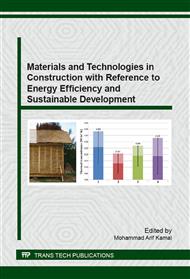[1]
G. Wood: The ICI Polyurethane Handbook; 2nd edition, John Wiley & Sons: New York (1990).
Google Scholar
[2]
C. J. Benning: Plastic Foams, vol. 1; John Wiley-Interscience and Sons, New York, (1969).
Google Scholar
[3]
M. Szycher: Handbook of Polyurethanes; CRC Press, Washington DC (1999).
Google Scholar
[4]
G. Oertel: Polyurethane Handbook; Hanser Publisher, New York (1985).
Google Scholar
[5]
T. Soubdhan, T. Fevillard and F. Bade: Experimental evaluation of insulation material in roofing system under tropical climate, Solar Energy Vol. 79 (2005), pp.311-20.
DOI: 10.1016/j.solener.2004.10.009
Google Scholar
[6]
ASTM C168-97: Standard Terminology Relating to Thermal Insulating Materials, ASTM International, (1997), www. astm. org.
Google Scholar
[7]
American Society of Heating, Refrigerating, and Air-Conditioning Engineers, ASHRAE: Handbook of Fundamentals, Chapter 23, Atlanta, GA (2001).
Google Scholar
[8]
B.A. Peavy: A Heat Transfer Note on Temperature Dependent Thermal Conductivity, Journal of Thermal Insulation and Building Envelopes, Vol. 20 (1996), p.76–90.
DOI: 10.1177/109719639602000107
Google Scholar
[9]
A.A. Abdou and I.M. Budaiwi: Comparison of Thermal Conductivity Measurements of Building Insulation Materials under Various Operating Temperatures, Journal of Building Physics, Vol. 29 (2005), p.171.
DOI: 10.1177/1744259105056291
Google Scholar
[10]
M. Lonescu: Chemistry and technology of polyols for polyurethanes, Rapra Tchnology Limited, Shropshire, UK (2005).
Google Scholar
[11]
W. J. Seo, D. H. Hwang, J. H. Park, W. N. Kim and H. S. Lee: J. Appl. Polym. Sci., Vol. 27 (2004) pp.2334-2342.
Google Scholar
[12]
H. Singh, T.P. Sharma and A.K. Jain: Reactivity of the raw materials and their effects on the structure and properties of rigid polyurethane foams, Journal of Applied Polymer Science, Vol. 106 (2007), pp.1014-1023.
DOI: 10.1002/app.26525
Google Scholar
[13]
M. Thirumal, D. Khastgir, N.K. Singha, B. Manjunath and Y.P. Naik: Effect of Foam Density on the Properties of Water Blown Rigid Polyurethane Foam, Journal of Applied Polymer Science, Vol. 108 (2008), pp.1810-1817.
DOI: 10.1002/app.27712
Google Scholar
[14]
I. Kellerhof: Pentane: An option for the production of CFC- and H-FC-free sandwich panels, Technical Information No. 1/1998, Bayer AG, (1998).
Google Scholar
[15]
J.W. Hastie: J. Res. Nat. Bur. Stand, A77, Vol. 6 (1973), p.733.
Google Scholar
[16]
J.W. Baker and J. Gaunt: J Chem Soc, Vol. 9 (1949), p.19.
Google Scholar
[17]
J.W. Baker, M.M. Davies and J. Gaunt: J C S, Vol. 24 (1949).
Google Scholar
[18]
H.A. Smith: J Appl Polym Sci, Vol. 7 (1963), p.85.
Google Scholar
[19]
J.W. Britain and P.G. Gemeinhardt: J Appl Polym Sci, Vol. 4 (1960) p.207.
Google Scholar
[20]
R.H. Stengard: Rigid Urethane Foams, Handbook of Foam Plastics ed. By Bender RJ, Lake, Libertyville, III, 126 (1965).
Google Scholar
[21]
B. Kumar and T.G. Decker: Journal of Cellular Plastic (1969).
Google Scholar
[22]
APTANE, http: /www. appliedpolymers. com. au/lng.
Google Scholar
[23]
M. Thirumal, Dipak Khastgir, Nikhil K. Singha, B. S. Manjunath and Y. P. Naik: Journal of Applied Polymer Science, Vol. 108 (2008), pp.1810-1817.
DOI: 10.1002/app.27712
Google Scholar
[24]
M. Yaocuanc, Y. Mariko and S. Nobuo: Journal of Applied Polymer Science, Vol. 60 (1996), p. (1939).
Google Scholar


